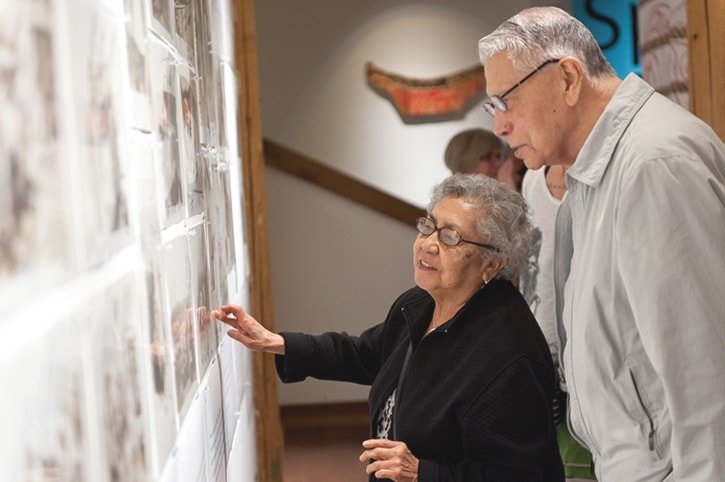ALERT BAY—For three decades, the empty, decaying hulk of St. Michael’s Indian Residential School has loomed over the U’mista Cultural Centre.
On Saturday, U’mista brought the school back to life with the unveiling of a unique exhibit that combines photographs taken by a young St. Michael’s student in the late 1930s with stories collected in interviews with residential school survivors.
Speaking to Memory — Images and Voices from St. Michael’s Indian Residential School was compiled by Bill McLennan, curator at University of British Columbia’s Museum of Anthropology, for display at last fall’s Truth and Reconciliation gathering in Vancouver. The museum has partnered with the U’mista Centre to display the exhibit in Alert Bay for a year.
McLennan was on hand Saturday for the grand opening of the exhibit along with 84-year-old Beverly Brown, who as a young girl shot most of the exhibit’s photos after being taken from her home in Fort Rupert to attend St. Michael’s.
A second-generation student at St. Michael’s, Brown was given a Kodak box camera by her father to take with her, and amassed a compelling and intimate representation of students’ lives at the school.
“At the time we first sought out images for the exhibit, the only thing available was from the historical archives,” said McLennan. “They were taken by the government or by the (Anglican) Church, and there was no humanity in those pictures.
“Beverly’s photos are not only unique, but they’re beautifully composed. You get the camaraderie that existed between students who were brought together from different areas of the coast; the kids all look relaxed.”
A young Beverly is also shown in a couple of the photos, out of school uniform and dressed in her weekend finery for a trip into town with friends.
“I let some of the other kids use the camera to take pictures, too, if they got their own film,” said Brown.
Each photo is covered by a clear, Mylar sheet and visitors who can put a name to any of the unidentified subjects are urged to use a nearby felt pen to write the name on the protected image.
The photos are accompanied by placards of text, from mostly anonymous former residents, describing anecdotes of life at the school or stories of their treatment by staff, escape attempts and punishments meted out for transgressions like speaking their native language.
The exhibit inside the U’mista Centre is accompanied by a series of wall-sized vinyl panels attached to the brick walls of St. Michael’s itself. Most are latter-day images of the empty shell of the building, overlaid with text from former church and school officials or from Truth and Reconciliation commissioners.
But one of the large banners is a simple, black-and-white photo taken by Brown. It shows a smiling Doris Hall, of Bella Bella, framed in one of the building’s upstairs windows, and the banner is strategically placed to put the life-sized picture of Hall in one of the building’s window openings.
“It’s an amazing documentary of the residential school experience, by someone who was inside that experience,” said McLennan.
Saturday’s grand opening was presided over by U’mista manager Sarah Holland, and featured a welcome blessing by ‘Namgis Chief Bill Cranmer and dancing by young students from Alert Bay Elementary School.
